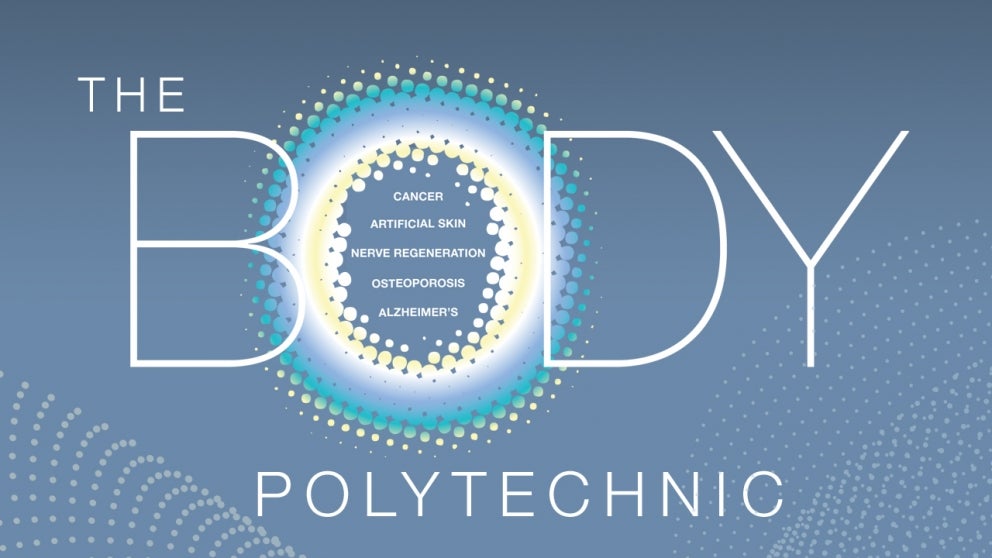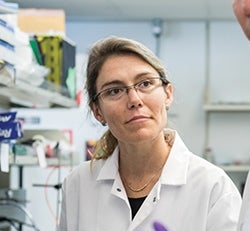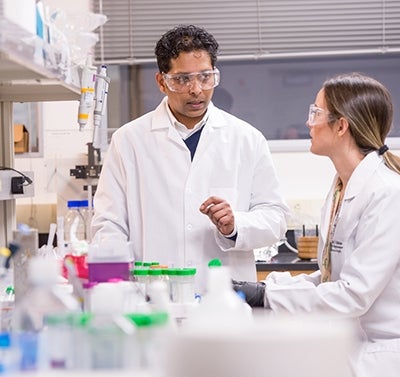

The Body Polytechnic
An interdisciplinary approach is transforming how scientists and engineers tackle health.
by Hazelle Lerum ’20
My mother was 61 years of age when she died of liver cancer 13 years ago,” Mariana Figueiro tells a rapt audience in the recording of her 2015 TEDMED talk. “She survived for eight months from the day she was diagnosed to the day she died. She never got out of bed after her first chemotherapy session. The side effects were horrendous.”

It’s an all-too-familiar experience, one that Figueiro has dedicated her life to helping patients avoid. Her work is based not in a hospital or a medical school, as one might expect, but in a place that may be a bit more surprising: the Lighting Research Center in the School of Architecture at Rensselaer, the country’s first technological university. She is one of a large — and growing — number of researchers at Rensselaer who, despite not working in a traditional medical institution, are devoted to finding new ways to improve and repair the human body, tackling everything from Alzheimer’s to nerve regeneration to cancer.
“Rensselaer is not a medical school or the type of organization one would traditionally associate with cancer research,” says Lee Ligon, associate dean of science for academic affairs. “But we have a lot of researchers engaged in interdisciplinary work that could contribute to the understanding of cancer biology.”
In 2016, Ligon was tapped to co-chair the Cancer Research Group, known as CARGO, along with Kristen Mills, assistant professor in the Department of Mechanical, Aerospace, and Nuclear Engineering. “A major goal of this group is to identify our unique expertise, explore the synergies in our work, and find ways to strategically deploy our knowledge to advance the broader cancer research agenda,” Ligon says.

Mills — who works in the same department as spacecraft navigation and nuclear fuel management experts — studies the mechanical properties and behavior of tumors. She also studies the biomechanics of a genetic disorder called neurofibromatosis 1, which often leads to cancer. She believes her team may be the first to study the disease in this way, providing new insight into its sporadic and unpredictable behavior. Deepak Vashishth, director of the Center for Biotechnology and Interdisciplinary Studies (CBIS), says that Mills’ exploration of the intersection of biomechanics and cancer cell biology as they relate to metastasis will “drive cancer research in an entirely new direction.”
As the director of CBIS — a 218,000-square-foot facility outfitted with state-of-the art laboratories and equipment devoted to collaborative research spanning multiple disciplines at the frontiers of life sciences, physical science, informatics, and engineering — Vashishth has a broad perspective on much of the health research being done on campus, from studying the biomechanics of cancer cells, to providing the “eyes” through bioimaging to see how those cells behave within living systems.
“We provide a new angle on human health,” he says. “Medical researchers have followed traditional pathways and achieved success in a number of fields, but certain areas have become saturated, and you’re not getting the next big thing or the next big solution. This can only come from our interdisciplinary approach.”

Pankaj Karande, associate professor of chemical and biological engineering and a member of CBIS, in collaboration with the Yale School of Medicine, recently created an artificial skin graft that could grow its own blood vessels. Currently, skin grafts that are commercially available are unable to integrate with the skin, and operate more like a Band-Aid — eventually falling off. Karande’s research is a significant step toward better treatment for people suffering from diabetic or pressure ulcers.
“As engineers working to recreate biology, we’ve always appreciated and been aware of the fact that biology is far more complex than the simple systems we make in the lab,” Karande says. “We were pleasantly surprised to find that, once we start approach-ing that complexity, biology takes over and starts getting closer and closer to what exists in nature.”
According to Karande, it will take more time and research to apply this technology to treating burn victims due to the challenges presented by nerve damage. But this puzzle may also be solved at Rensselaer, where nerve regeneration is also an area of focus for research. Ryan Gilbert, associate professor of biomedical engineering, is looking into how certain cells can promote or hinder recovery in patients who have experienced spinal injury, which may someday help solve the problem in nerve genesis in artificial tissue.
Vashishth has found his own research interests drawn to new and unexpected areas by his interactions with colleagues at Rensselaer. A renowned osteoporosis researcher, his past work largely centered on what he described as “making old bones new again” by using a compound that dissolves sugary impurities found within bone tissue to reverse bone fragility. However, through a collaboration with microbiologist Blanca Barquera, a professor of biological sciences, his focus has shifted to the gut.
Barquera and Vashishth are exploring a protein that is produced by bone cells but modified by bacteria in the gut in ways that affect the regulation of brain function. Together, they hope to find a connection between osteoporosis and Alzheimer’s disease. “If you think about vertebrates, which are known to have high cognition, it’s almost as though the skeleton exists with cognition,” Vashishth says. “The question this creates is: Does the skeleton have anything to do with the brain and cognition?”
Meanwhile, across campus, Figueiro is exploring how brains affected by Alzheimer’s relate to light. A light therapy developed by Figueiro and her team has been shown to improve the cognitive performance, memory, and sleep quality for patients in actual treatment facilities for Alzheimer’s patients, as well as those with dementia, mild cognitive impairment, traumatic brain injury, and other conditions. Figueiro envisions a future in which all assisted living facilities are outfitted with bright lights that are providing light therapy to patients automatically.
“It’s such a simple, elegant solution — it’s not pharmacological. And it’s exciting to see that every way we look at it, we’re seeing this positive effect,” she says. “I think the most interesting thing about the Lighting Research Center is its ability to use light to help people, from premature infants to people with Alzheimer’s disease.”
Much of Figueiro’s research is conducted in collaboration with the Icahn School of Medicine at Mount Sinai, as is the research into Alzheimer’s being done by Chunyu Wang, associate professor of biological sciences. Wang is exploring whether certain molecular inhibitors can block the production of proteins that contribute to cognitive decline in Alzheimer’s patients. His work is yet another facet of the ongoing efforts at Rensselaer to take on the challenge of this disease, and it highlights the importance of external collaboration in the university’s unique position as a mover and shaker in health research despite not having its own medical school.
“What I am most excited about is when a particular human is able to walk out of a hospital because of something we did here at Rensselaer,” Vashishth says. “I would say that’s coming soon. One day, you will open a newspaper and see a headline that says of some disease, ‘RPI Researchers Solved This.’”















